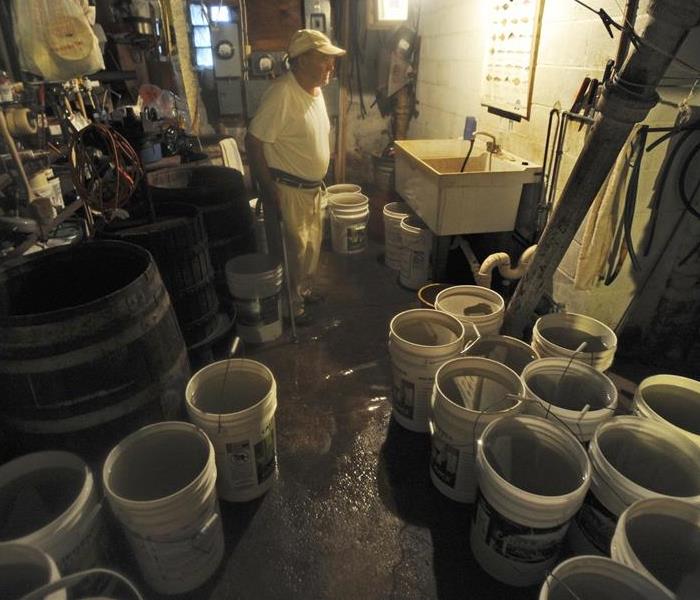Water and Sewage Backup
3/30/2016 (Permalink)
Water and Sewage Backup
There are 3 Categories of water damage..how dirty is your problem…..When you have a water damage in your home it is good to know how severe your problem is. No matter if the water damage is in your basement, from a washing machine overflowing, in your kitchen because your dish washer line let go while you were at work, or in the bathroom because the football team visited and your toilet overflowed and cannot handle 15 teenage boys. The type of water that is all over your home makes a huge difference.
Clean water -Broken pipe, leaky faucet
Gray water- dishwasher, Urine w no fecal matter, Washing machine
This water can quickly turn into stage 3 if not handled quickly.
Black water- Standing water overflow w fecal matter, Flooding waters
Note: Sewage back up should be handled immediately and considered an emergency since the water may contain viruses’ bacteria and other microbes that can cause serious illness. The severity of the health threat is going to depend on the source of the water and the extent of penetration into the home or business. How the water enters the area and the materials that are affected along with the time that the water sits will have an impact on extent of the damage is. Even floodwater or storm water which has not been directly impacted by sewage discharges is likely to contain a wide variety of microbiological organisms (e.g., from animal wastes, street runoff, etc.) and must be properly managed. Some of these pathogens, such as mold spores, can even establish themselves long after the water has receded.
Obviously the ideal thing to prevent the problem but that is not always feasible and sometimes being pro-active and taking quick action are paramount. Mitigating the risk of infection is important to keep you and your family healthy.
Prevention:
If a home is located in an area subject to periodic flooding (such as in a floodplain) or where sewage backups have occurred, the homeowner should implement "all feasible measures" to prevent/minimize the nature and extent of impacts from such situations. Such actions can be preventive or pro-active.
Preventive actions include:
1. waterproofing the building foundation and/or sealing cracks in foundation floor or walls;
2. installation of a check valve or shut-off valve on the building sewer close to where it enters the structure, which will protect your home from sewage back-ups due to surcharging conditions in the municipal sewerage system (you must check with the proper sewer authority prior to taking this action!!); and
3. raising or removing any sink, toilet, washing machine, etc. in the basement that may be subject to backups when the sewer system surcharges.
Pro-active measures include:
1. purchasing or installing a pump (e.g. sump pump) to pump out water that collects in the low point of the basement or structure;
2. ensure that building gutter downspouts and drains are directed away from the foundation and toward low points away from the home;
3. to the extent possible, keep furniture and valuables above flood levels where flooding has previously occurred; and
4. if minor flooding occurs, follow the water to its point-of-entry and seal cracks or defects to the extent possible.
Remember, an ounce of prevention is worth more than a pound of cure. Flood insurance is also vitally important where properties are known to be in floodplains or flood prone areas. More information on prevention and flood insurance is available on the FEMA website.
Cleanup of Internal Areas
Once the flood waters have receded and the property can be accessed safely, cleanup operations should commence -Remember to check with local emergency management officials before returning to a property affected by flooding! The most important steps are to restore the environment to a dry state and salvage any valuable property. The longer that water/waste are allowed to remain in your home or on your property, the greater the potential for illness and irreparable damage to your home, its contents, and environs. Where they may be operated safely, use of pumps and dehumidifiers will be helpful in restoring dry conditions. In any flood cleanup project regardless of the source,one should assume that pathogens are present and take appropriate precautions.
The survival of pathogens depends on a number of factors: location (indoors vs. outdoors), season, type of surface contaminated, whether disinfectants are used, and also on environmental conditions such as humidity, temperature, and sunlight. Sunlight (UV radiation) reduces the survival rate of pathogens with numbers decreasing rapidly with increasing exposure to UV radiation. Mild temperatures and higher humidity in external situations result in longer survival times.
As always when there is water damage assess the level of intrusion, type of water, and make sure when in doubt you call a professional there is a lot at stake, because at SERVPRO family matters. The guidance of experienced professionals and public health officials who are able to view a home and assess the needs of your particular situation can make all the difference




 24/7 Emergency Service
24/7 Emergency Service
